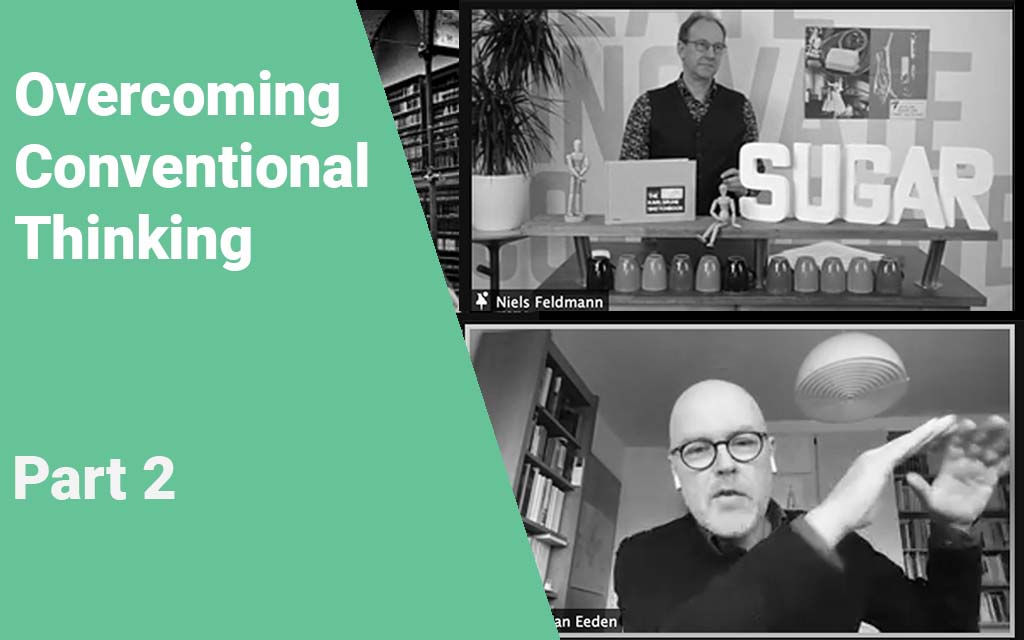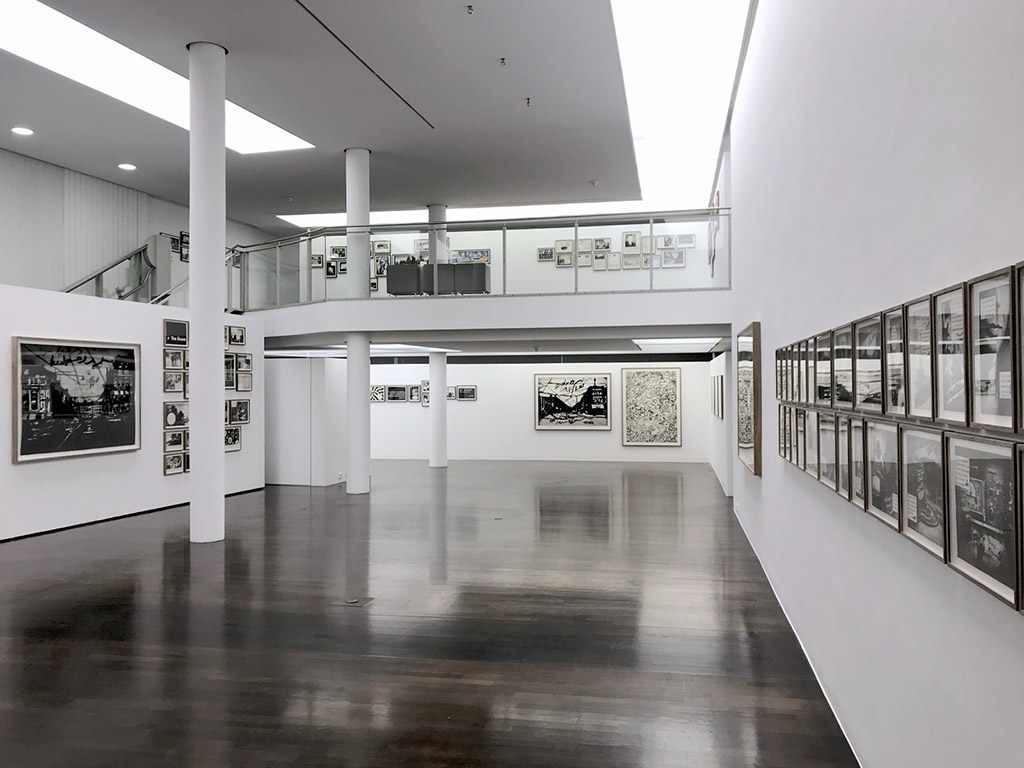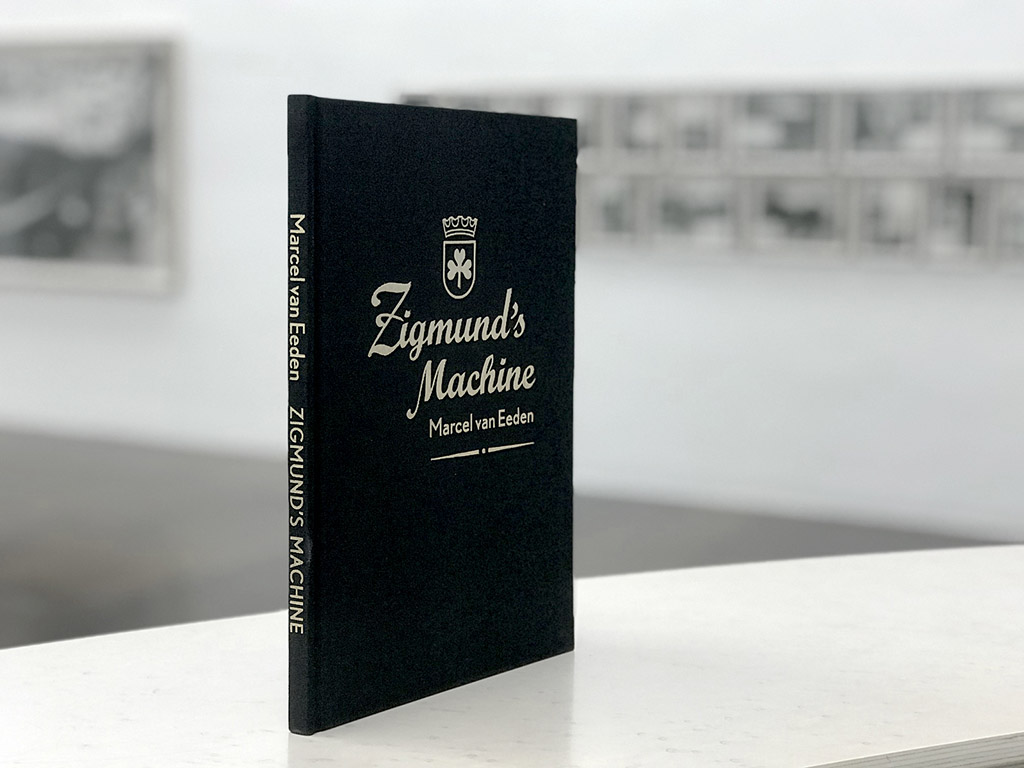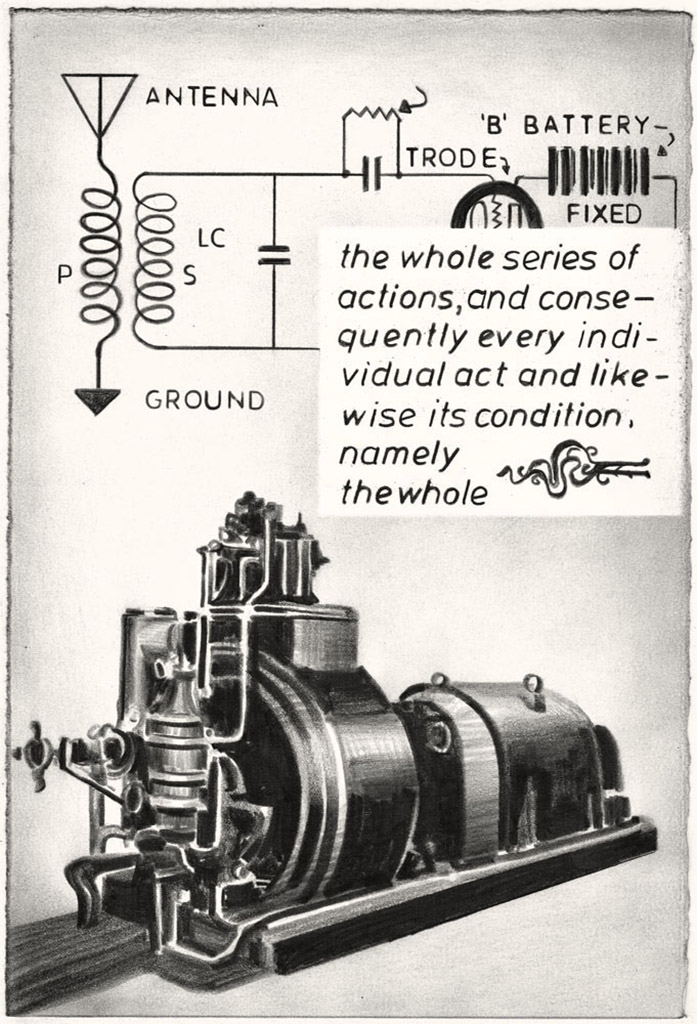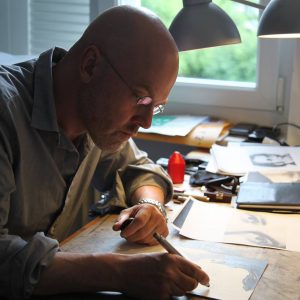Overcoming format restrictions
We understood how important it is to create an pointed but unusual problem definition. In the second part of Overcoming Conventional Thinking we talk about techniques that Marcel uses when responding to the problem (minutes 6:19 – 16:54 in the video).
From Stills to Stories
RW: One of the things you do is to create stories, partly factual and partly fictional around your material. Does the idea of the story influence how you depict a certain photograph? I.e., does the process of storytelling, apart from creating the story, also influence your representation of the photograph, the way you draw it?
MvE: No, I don’t think so. The whole idea of storytelling stems from the fact that I originally wanted to be a writer – which I didn’t become. Instead, I made single drawings which initially had the same size but were still single drawings. However, when they were hung side by side, it seemed like people wanted to see a story. And in fact, when you hang them up one behind the other, you feel like there is a connection between them or there is a story. In the end, a real story developed from this, in which all the material found, all the photos and also the texts I found, date back to before 1965.
Inspiration by the viewers
NF: If I understand you correctly, the drawings seem to form a story when hanging them next to each other. So, is this story a coincidence or is the story designed?
MvE: In the beginning it was a coincidence because people saw stories. And I could see stories too. But in the end, it was interesting for me to create real stories and connect all the drawings with text. My later works look almost like comics. In fact, they’re not comics, but they look similar. So, now there are stories, even though it wasn’t my intention in the beginning. It’s something that has gradually developed.
That’s why there are so many possibilities in this very small and simple idea. It even astonishes me that it’s still going on. I still don’t fully understand the idea, but you can find so many philosophical or artistic questions related to it.
Creating stories people can relate to
NF: Where do your stories come from? From the pictures or from somewhere else?
MvE: Mostly it’s a problem definition. If I’m invited to a show somewhere, I aim to create something specifically for that show. I want to create something that is related to the location or the visitors of the show. It’s nice to be able to establish closer contact with the visitors to the exhibition by working with material that they know.
For example, a few years ago, I had an exhibition in Fürth near Nuremberg. In such situations, I usually do research on the history of the place. This is how I found out that Fürth is the city in which two consumer electronics manufacturers were founded around the same time, Grundig and Metz. So, I developed a story based on that history.
Zigmund's machine
From Grundig and Metz I derived the name Zigmund, which is a kind of anagram of these two company names. In this story, Zigmund is a company in Fürth that has developed a new machine that is again the focus of my story. Accordingly, the title of the exhibition and the accompanying book is “Zigmund’s Machine” (Städtische Galerie Fürth, Zigmund’s Machine, 13.01. – 24.02.2019, LINK).
After identifying the name and subject of the story, I look for old pictures of Fürth. When I then draw these old pictures, the exhibition visitors recognize the locations of their own city. So, my drawings and my story are more connected to viewers. From there the story evolves and I breathe life into the old photos – they take on a life of their own, so to speak. When the drawings are part of this story something happens. A picture becomes more than just a simple drawing of a place. People walk around because now there’s text, there is something happening, there is development, there’s a machine invented.
Embedding a deeper meaning
NF: In your example, your story and drawings are created from a place, its history, and local photographs from before 1965. Right?
MvE: Yes, first I make a synopsis of a story that I want to tell. In this case, it’s about a machine that makes energy from the will of Schopenhauer. I find it an interesting idea. In his work, Schopenhauer talks about the will. Somewhere deep down in nature is this energy that makes everything alive, living and growing. It’s a force of nature that you cannot stop and that goes on and on.
And there is a character named Gert Zigmund. He developed that machine which taps into the will and extracts energy from it. Which is a very topical theme, to find energy or electricity in something natural. This was my initial synopsis. Then I started looking for photos of Fürth and old machines, but the latter did not necessarily come from Fürth.
Complementing the story with text
Next, I start to write texts with the help of the Internet. I do not write the text myself because my English is not good enough for it. Initially, I used search engines, but then I switched to, for example, Google Books or the British Newspaper Archive, a website with all the British newspapers. I search for sentences there.
For instance, if somebody had to arrive at the station I look for “he arrived at the station”. And then I can of course use this parameter ‘before 1965’. When I find all excerpts from books where somebody arrives at the station, I can take these sentences and I put them into the drawings. The next sentence is perhaps about the protagonist going to a restaurant, and I look for a corresponding quote from a completely different book. Subsequently I glue it together. So, the text is also a bit weird because sentences come from a different tone.
From story to collage
So, drawing and text combined are kind of a collage. It’s a chaotic thing that comes together. In a coincidental way a story emerges from all the material. You bring something to life and that’s really interesting and I like it a lot.
Recap & Take-Away
In this part Marcel sheds more light on the development of the problem definition as well as on his approach to create an answer to it:
- [Take-Away] Complicate the problem: In Part 1 we learned that Marcel creates a problem definition by contrasting a given topic with his self-imposed rules (images from before 1965). In this part he tells us that he complicates the problem even more. In his example (Fürth case) he creates and artwork that brings topic A (Schopenhauer’s will), topic B (exploiting energy from nature), a location with its history (Fürth, Grundig, Metz) and his rules into association.
- [Take-Away] Add remote associative elements: Marcel increases the number of remote associative elements in the problem defintion (topic A & B, location, rules) as well as when creating the artwork (i.e. text sequences from different sources). Bringing these elements into contiguity makes the challenge tougher but may also facilitate a more original outcome.
- [Take-Away] Challenge assumptions regarding the outcome’s format: Moreover, Marcel challenges the assumption that a drawing is a single piece. The switch to stories, i.e. conected drawing, open up new possibilities to address complex topics.
- [Take-Away] Leveraging familiarity as a door opener: The use of pictures from the city of the later exhibition serves two functions: The pictures are a further associative element in the creative process and thus contribute to an original result. Above all, however, pictures from the exhibition space may serve as door openers for the viewer, i.e. invite them to enter into a dialogue with the work of art.
Marcel van Eeden (*1965, Den Haag/NL)
Lives and works in Den Haag/NL, Karlsruhe/DE, Zürich/CH
Professor at the State Academy of Fine Arts Karlsruhe since 2014
Rector of the State Academy of Fine Arts Karlsruhe from October 2021
Web: https://www.marcelvaneeden.nl/
Galleries:
Sprueth Magers, Berlin | London | Los Angeles
Galerie Barbara Seiler, Zurich
In Situ/Fabienne Leclerc, Paris

